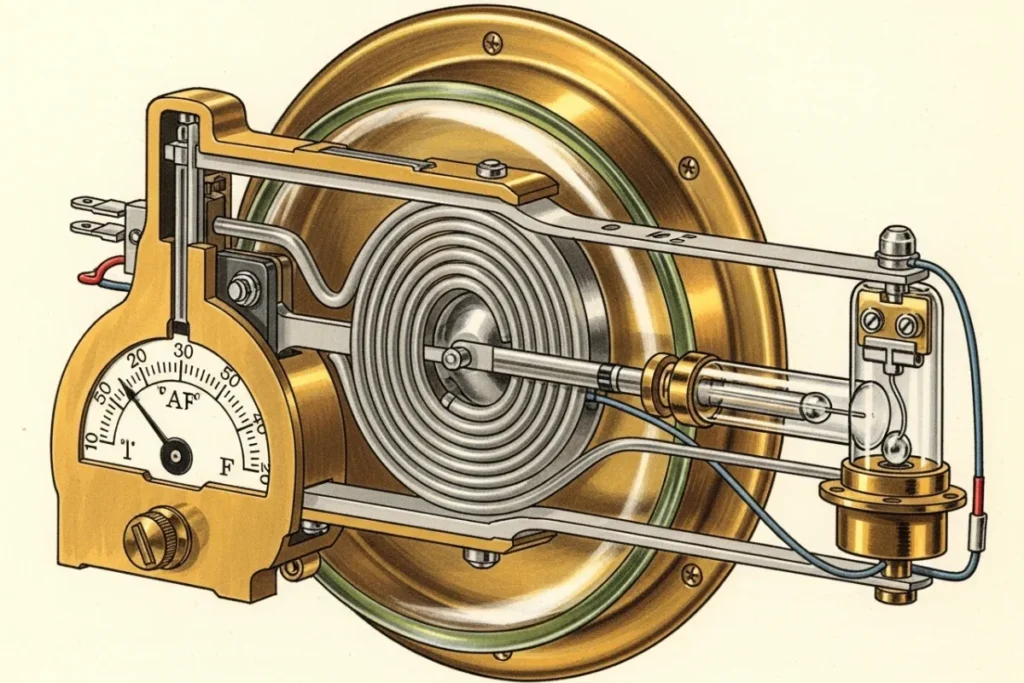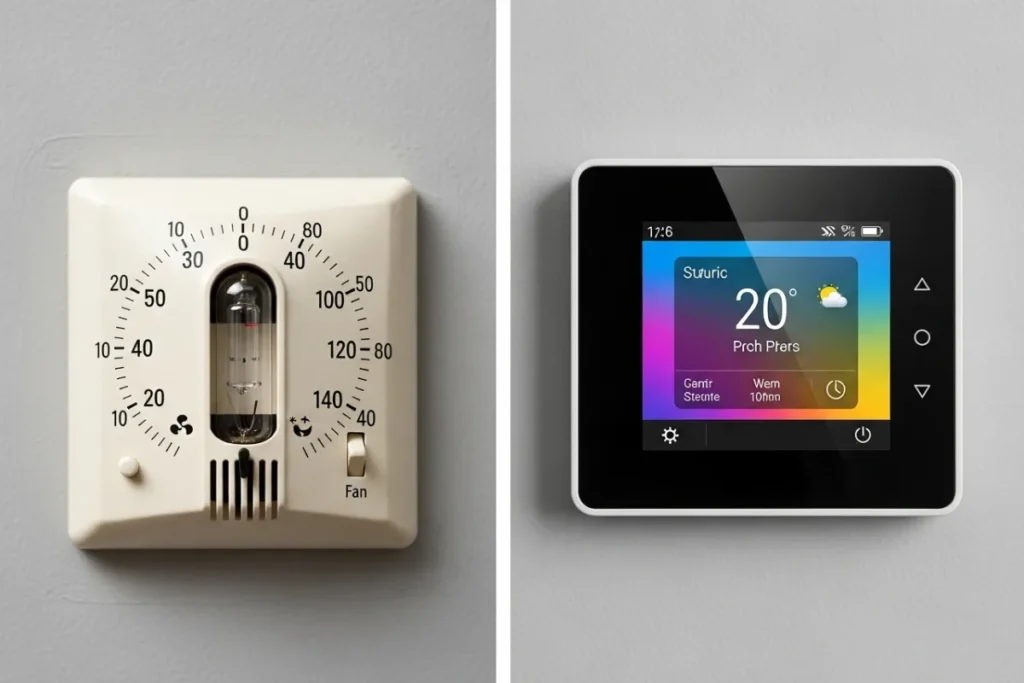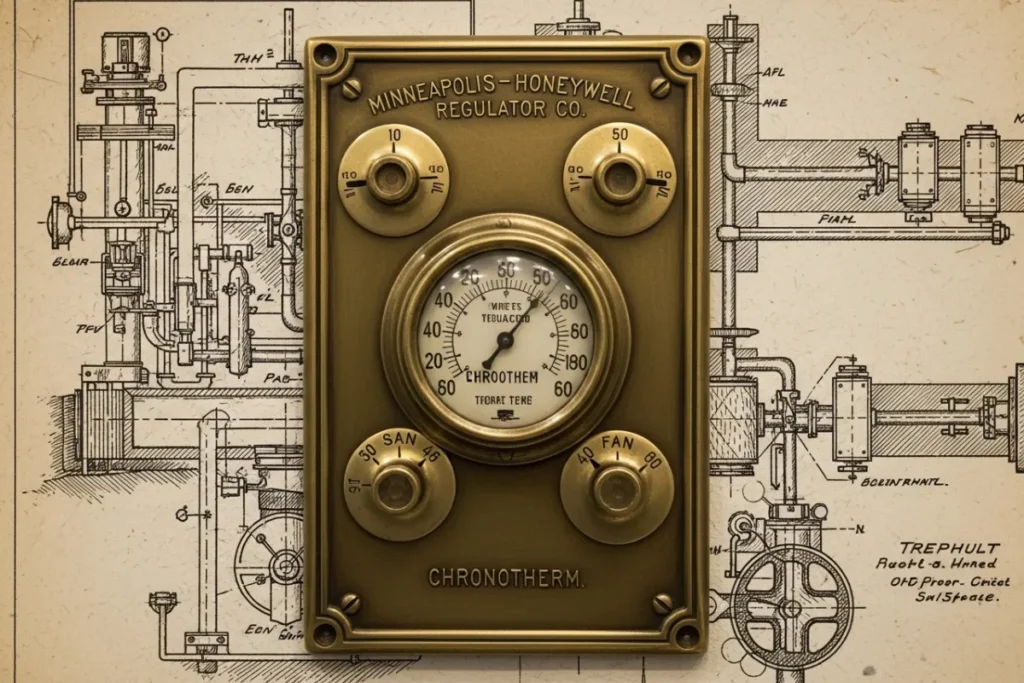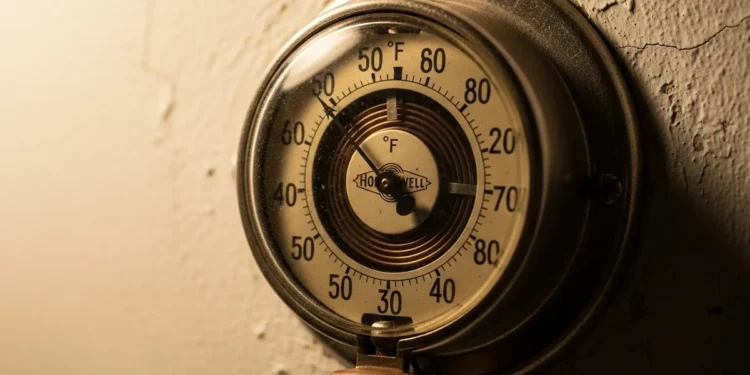Explore the evolution of home temperature control, from the early mechanical history of the thermostat to today’s smart devices. Understand how HVAC technology has transformed comfort in our lives, reflecting social changes, class divides, and the importance of sustainability. Discover the role of innovation in enhancing personal well-being and environmental awareness. Learn how modern advancements, including AI and IoT integration, affect the future of climate control and democratize comfort across different socioeconomic backgrounds.
Table of Contents
The Evolution of Comfort to the History of the Thermostat
In the context of modern living, the thermostat plays an essential role in shaping our everyday experiences by providing an environment that maximizes comfort. This critical device not only regulates the climate within our homes but also influences our emotional state, connecting us to an intricate history of temperature control advancements. The evolution of home temperature control has transitioned from rudimentary mechanical systems to the sophisticated smart thermostats of today, marking significant milestones in HVAC technology history.
Initially, thermostats were basic mechanical devices, primarily utilizing bimetallic strips that expanded and contracted with temperature fluctuations. These early inventions, while functional, often failed to provide the precision necessary for optimal comfort, thereby limiting the experience of warmth during chilly winters or coolness during scorching summers. The origins of smart history of the thermostat technology trace back to the late 20th century, when digital controls began to emerge, laying the groundwork for modern climate control inventions that respond to user preferences and habits.
The advancements in the history of thermostat technology also mirror societal changes, particularly concerning heating and class divide. In the past, only affluent households had access to advanced heating systems, resulting in a stark contrast in living conditions. As HVAC technology became more accessible, it revolutionized home heating, allowing a broader demographic to enjoy enhanced comfort, which played an essential role in the emotional well-being of the residents.
Understanding the evolution of home temperature control not only enlightens us about the practical aspects of HVAC systems but also resonates with our emotions tied to comfort and well-being. The journey from metal rods to silicon chips illustrates how closely intertwined our daily comfort is with technological advancements, shaping our living spaces and, ultimately, our lives.
The Mechanical Era: Cold Steel and Concepts of Control
The evolution of home temperature control can be traced back to a time when mechanical thermostats made their debut, bringing forth a significant shift in how individuals perceived and managed their living environments. These early devices, characterized by their cold steel design, laid the groundwork for modern HVAC technology. The simplicity of their functionality belied the complexity of the comfort they aimed to provide. Typically constructed with metallic elements that responded to temperature changes, these thermostats would engage or disengage heating mechanisms, enabling occupants to maintain a desired indoor climate.
During this mechanical era, the concept of climate control was closely tied to notions of comfort and well-being. As industrialization expanded, so too did the availability of heating technologies in homes. However, the societal implications of such advancements cannot be overlooked. Ownership of heating devices and the ability to regulate temperature became indicators of social status, revealing a distinct class divide. Those who could afford these luxuries enjoyed the comfort and convenience that accompanied controlled heating, while others remained reliant on more primitive means of warmth.
The advent of mechanical thermostats marked a pivotal point not only in individuals’ comfort levels but also in the collective mindset regarding temperature regulation. With their introduction, people began to regard their living spaces as customizable environments, rather than static shelters subject to the whims of nature. This shift in perception paved the way for further innovations in climate control, setting the stage for what we would later recognize as the smart history of the thermostat origins. As a result, the history of HVAC technology is not merely a tale of mechanical advancements; it reflects broader social changes and evolving concepts of ownership and comfort within the home.

The Industrial Revolution: Thermostats and Class Distinctions
The Industrial Revolution marked a pivotal moment in the evolution of home temperature control, which became increasingly significant in distinguishing class differences within society. As factories and urbanization reshaped the landscape, the centralization of heating systems began to emerge, leading to the sophistication and eventual proliferation of devices such as history of the thermostat. The advent of HVAC technology marked a departure from traditional heating methods, expanding access to climate control but simultaneously revealing disparities in privacy and comfort across social strata.
For the affluent classes, the introduction of the smart thermostat signified a new era of convenience and luxury. Homes equipped with advanced heating systems allowed families to maintain optimal comfort levels, symbolizing prosperity and social status. In stark contrast, the working class, often residing in less desirable living conditions, was frequently deprived of such technologies. Their reliance on primitive heating solutions left them exposed to the elements, emphasizing a stark divide in the quality of life and comfort that directly correlated with wealth and class standing.
Furthermore, the connection between heating systems and social privilege was evident as well. Those who had the financial means to invest in sophisticated HVAC solutions not only enjoyed enhanced physical comfort but also had the luxury of modern conveniences, including the ability to control their environment seamlessly. This dichotomy highlighted broader societal issues, underpinning how the evolution of home temperature control became inextricably linked with notions of class divide. The ability to manipulate one’s surroundings and the comfort it afforded came to represent broader societal ideals, illustrating how technological advancements operated within the social framework of the time.
In conclusion, the development of thermostat technology during the Industrial Revolution underscores the intricate relationship between innovation and social status. As climate control inventions such as thermostats transformed how people experienced their homes, they also reflected and reinforced existing class distinctions, intertwining the histories of technology and society in profound ways.
Telecommuting Era: Digital Thermostats and Personalization
The transition to digital history of the thermostat during the late 20th century marked a significant evolution in home temperature control, profoundly impacting how individuals engage with their living spaces. This era was characterized by rapid advancements in HVAC technology, which facilitated the development of sophisticated digital devices that allowed for greater personalization of comfort. As homes transitioned into the era of telecommuting, the importance of a comfortable workspace became paramount. Digital thermostats transformed the way individuals interacted with their environment, offering customizable settings that could be tailored to personal preferences.
With the advent of smart history of thermostats, consumers gained unprecedented control over their heating and cooling systems. Unlike their analog predecessors, which merely regulated temperature, these digital devices incorporated programmable capabilities and learning algorithms. This technological innovation enabled occupants to create personalized schedules and adjust settings remotely, ensuring optimal comfort in their homes and workplaces. Such features not only enhanced individual experience but also connected emotional well-being to temperature control, highlighting the intersection between technology and human experience.
This personalization brought to light the concept of inclusivity in climate control, addressing varying needs influenced by factors such as age, health, and lifestyle. Moreover, the ease of accessibility of these smart devices helped narrow the class divide historically associated with heating choices. Digital history of the thermostat democratized comfort by allowing more individuals to harness advanced HVAC technology, regardless of economic background. In this manner, the evolution of home temperature control transcended mere functionality; it evolved into a reflection of personal identity and preferences, aligning comfort with emotional satisfaction.
In conclusion, the late 20th century’s shift towards digital history of the thermostat encapsulates not only a technological transformation but also a profound reinterpretation of how individuals perceive and manage their environments. Through personalization, individuals gained a greater sense of autonomy and connection to their spaces, underscoring the emotional facets of temperature regulation.

The Rise of Smart Thermostats: Connectivity and Control
The last few decades have seen significant advancements in the evolution of home temperature control, with the smart history of the thermostat emerging as a transformative technology that enhances the convenience and efficiency of climate regulation in our living spaces. These innovative devices, which can be programmed to learn user preferences, represent a fusion of traditional heating systems and cutting-edge smart technology. The origins of smart thermostats trace back to early programmable models introduced in the late 20th century, which laid the groundwork for more sophisticated developments in HVAC technology.
One of the most notable features of the smart history of thermostats is their remote access capability. Users can now control their home climate from anywhere in the world using mobile applications. This connectivity fosters a sense of autonomy and control over one’s environment, impacting the emotional and psychological aspects of how we relate to our homes. The ability to adjust heating and cooling settings while away not only enhances energy efficiency but also alleviates anxiety over energy consumption, allowing homeowners to manage their resources thoughtfully. The integration of learning algorithms also contributes to this intricate relationship; these devices can adapt over time, tailoring temperature settings based on user habits and preferences.
This intelligent responsiveness aligns with broader societal trends toward sustainability and energy conservation, addressing not only individual comfort but also wider environmental concerns. However, the rise of smart thermostats has not been without critique. There are ongoing discussions regarding the implications of technology on social divides, particularly the potential for disparity in access to such advanced climate control inventions. As these devices become commonplace in many households, it is vital to consider the impact on those who may not afford these innovations. Overall, smart thermostats serve as a testament to the evolving dynamics of human interaction with technology and its role in shaping our living environments.
Cultural Perspectives: How Different Societies View Comfort
Comfort is a multifaceted concept influenced by cultural norms and environmental conditions. Different societies have unique perceptions of comfort, particularly when it comes to home temperature control. In many Western countries, the evolution of home temperature control has prioritized technological convenience. The introduction of the smart thermostat, embedded with advanced HVAC technology, reflects a desire for precise control over indoor climates, fostering an expectation for a comfortable living environment year-round. Conversely, in several cultures, comfort is less about temperature regulation and more about communal experiences and simple living, which can often lead to a lower reliance on mechanical climate control inventions.
For example, in Scandinavian nations, there is a strong emphasis on the concept of ‘hygge,’ which translates roughly to a cozy ambiance. Here, the appreciation for warmth and comfort extends beyond a smart thermostat or efficient heating systems. Instead, it hinges on design choices, communal activities, and mindset. On the other hand, in regions where the climate is extreme, reliance on technology for comfort becomes more pronounced. The history of HVAC technology reveals that in desert environments, for instance, the use of air conditioning systems is not merely a luxury but a necessity for survival.
Moreover, the heating disparities often highlight class divides within societies. In developing nations, access to modern heating solutions may be limited, leading to alternative practices around temperature control. Community and cultural practices often fill the gap, showcasing the creativity and resilience of individuals in adapting to their climatic realities. As technology advances globally, the coexistence of traditional comfort practices alongside modern smart history of the thermostat origins raises interesting discussions about how various societies will bridge or widen the comfort divide. Ultimately, understanding these cultural perspectives can offer insights into how comfort is valued and managed across different parts of the world.

Environmental Impact: Thermostats and Sustainable Living
The evolution of home temperature control has dramatically reshaped the way we interact with our living environments, particularly in the context of sustainability. With increasing awareness regarding climate change and energy conservation, the history of the thermostat has emerged as a pivotal tool that not only enhances comfort but also advocates for responsible energy usage. As homes became more technologically advanced, the development of smart thermostats allowed for precise temperature management, reducing unnecessary energy consumption.
Smart history of the thermostat origins can be traced back to basic temperature regulation devices, but modern advancements have paved the way for features such as remote control and learning capabilities. These functionalities foster a more nuanced approach to heating and cooling, enabling homeowners to optimize energy usage according to their routines. This proactive management of HVAC technology history is critical in decreasing energy waste and associated carbon footprints. The integration of such devices aligns emotional well-being with eco-conscious living, as comfortable environments contribute not only to personal satisfaction but also to a more sustainable future.
Thermostats play a crucial role in bridging the gap between comfort and ecological responsibility. The responsible use of these devices can lead to significant energy savings, ultimately preserving natural resources. The societal implications of heating and class divide underline the importance of accessibility to efficient temperature control systems. Without equitable access to innovative climate control inventions, disparities in energy consumption and environmental impact can widen. Hence, promoting the intelligent use of thermostats in homes across all socio-economic strata becomes essential in tackling the pressing challenge of sustainability.
In conclusion, the thoughtful integration of thermostats in daily life not only improves energy efficiency but also fosters sustainability and environmental mindfulness. As technology progresses, the evolution of home temperature control continues to inspire a collective responsibility towards conservation and a greener planet.
The Future of Thermostats: AI and Beyond
The evolution of home temperature control has evolved remarkably, thanks not only to technological advancements but also to the desire for enhanced comfort and environmental mindfulness. As we gaze into the future of thermostats, artificial intelligence (AI) emerges as a key player in further enhancing our climate control inventions. The integration of AI into smart thermostats has the potential to revolutionize how we interact with our living spaces, creating an emotionally attuned ecosystem that responds intuitively to our needs.
Smart thermostat origins can be traced back to basic programmable devices that allowed users to set heating and cooling schedules. However, AI enables a more refined approach by utilizing machine learning algorithms to analyze user behaviors and preferences continuously. This evolving technology can predict the optimal temperature settings based on individual habits, weather forecasts, and even fluctuating energy costs. Consequently, homeowners can experience a seamless blend of comfort and energy efficiency that was once unimaginable.
Moreover, the integration of AI with IoT (Internet of Things) devices creates a network of synchronized technology that can optimize HVAC systems. Imagine a scenario where your thermostat communicates with other smart elements of your home, such as shades or windows, to regulate indoor climate efficiently. The importance of heating about the class divide cannot be understated either, as these advanced systems may allow for more equitable access to comfortable living environments, irrespective of socioeconomic status.
In considerations of HVAC technology history, it is clear that we stand on the precipice of a new era marked by rapid innovation and interconnectedness. As AI-driven technologies become more integrated into our daily lives, our emotional relationship with temperature control will likely deepen, transforming the way we perceive comfort. As we embrace these advancements, the future of thermostats promises not just enhanced functionality but also a more emotionally intelligent approach to home climate management.
| Aspect | Description |
|---|---|
| Evolution of Thermostats | From simple programmable devices to AI-powered smart systems |
| Role of AI | Helps address the class divide by enabling wider access to comfortable living environments |
| Integration with IoT | Helps address the class divide by enabling wider access to comfortable living environments |
| Benefits | Enhanced comfort, improved energy efficiency, and potential for equitable access to heating |
| Social Impact | Helps address class divide by enabling wider access to comfortable living environments |
| Future Outlook | AI-driven, emotionally attuned ecosystems that transform our interaction with home temperature control |
Conclusion: The Lasting Impact of Thermostats on Society
The evolution of home temperature control has significantly shaped both individual comfort and broader societal structures. From the first rudimentary heating solutions to the sophisticated smart thermostat origins we see today, these devices have transformed the way we interact with our living environments. Historically, access to efficient heating mechanisms delineated social classes, influencing housing markets and living standards. The disparities in HVAC technology history illustrate a stark heating and class divide, where wealthier households could afford advanced systems that provided not only comfort but also a level of control over their home climate that was unavailable to the less affluent.
At the core of this evolution lies the invention of climate control technology, which began as a necessity for survival and has evolved into a pivotal aspect of modern living. The advent of smart thermostats has brought about a revolution in how temperature is maintained, further enhancing energy efficiency and user engagement. (learn more about smart thermostat technologies and their impact on energy saving here.) These innovations have not just improved individual quality of life; they have also prompted a wider cultural shift towards sustainability and environmental awareness. As smart devices become more commonplace, they weave themselves into the fabric of daily life, inviting questions about dependency on technology and our relationship with the environment.








